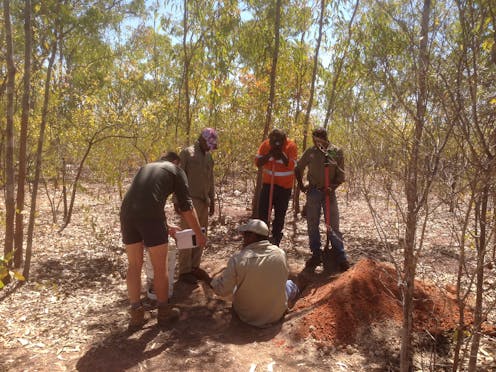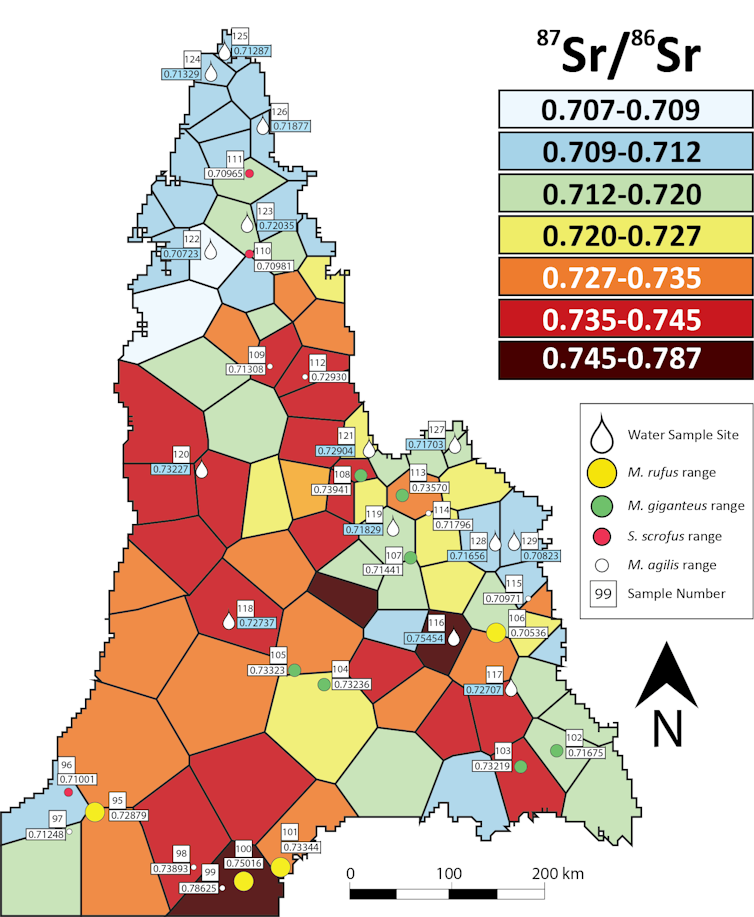 Normanton Aboriginal rangers and archaeologists reburying the skeletal remains of Gkuthaarn and Kukatj children back on country.Michael Westaway, Author provided
Normanton Aboriginal rangers and archaeologists reburying the skeletal remains of Gkuthaarn and Kukatj children back on country.Michael Westaway, Author providedTo mark the International Year of the Periodic Table of Chemical Elements we’re taking a look at how researchers use some of the elements in their work.
Today’s it’s strontium, a chemical that can help fireworks burn red. It’s also an element that is naturally found in teeth and can be used as way to identify where somebody grew up.
Thousands of skeletal remains of Aboriginal people are kept in museums across Australia, North America and Europe.
Many Aboriginal people refer to these collections as ancestral remains. Although some have now been returned to their descendant communities, many more await return.
The challenge is knowing where to return them.
One estimate is that up to 25% of Aboriginal remains held in Australian institutions have no details of where they were taken from.
Read more: What teeth can tell about the lives and environments of ancient humans and Neanderthals
Our study, published today in the journal GeoArchaeology, aims to tackle the issue of repatriating such remains.
Our work uses the element strontium to determine specifically where somebody grew up. Strontium is an element in all rock and is transferred into body tissues.
Chemical help with the past
Strontium, named after Strontian, a small town in western Scotland, is described as a soft, silvery metal that burns in air and reacts with water.
For decades the ratio of two forms of strontium (the isotopes ⁸⁷Sr/⁸⁶Sr) have been measured in archaeological and palaeontological material. These have helped in answering questions that relate to the behaviour of past populations.
Perhaps the most famous study involved the 5,000-year-old ice man Otzi who was found in the European Alps. Strontium isotopes in Otzi’s teeth helped scientists determine where he was born in northern Italy, which added to our understanding of the mobility of ancient European populations during the Chalcolithic period – the Copper Age from about 3500BCE to 2300BCE.
Here in Australia, the strontium technique has had some use in a few cases, but in general is underutilised.
More than DNA
In a complementary project focusing on DNA, research has shown that genetic material can be used to help locate Aboriginal populations.
But the recovery of ancient DNA from many ancestral remains in Australia continues to prove challenging. Australia’s harsh environmental conditions lead to a poor state of preservation in many remains. This makes the recovery of biological material for DNA analyses difficult and in some cases not at all possible.
Using the isotope chemistry of tooth enamel and bone we can bypass these issues of preservation. The strontium-based process involves measuring a robust geochemical signature, not a biological one subject to decomposition.
Tooth enamel is the hardest substance in the human body and can hold evidence of the region where a person lived as a child. This makes it a suitable material to establish where a person was originally from. Bones are also useful as they help provide information about the burial site.
We use strontium isotopes to help with resolving the issue of provenance: the place where people belong.
The abundance of isotopes
The element strontium (chemical symbol, Sr) has an atomic number of 38 and four forms known as isotopes, ⁸⁴Sr, ⁸⁶Sr, ⁸⁷Sr and ⁸⁸Sr. Although these isotopes are stable, their natural abundance changes.
In particular, the amount of ⁸⁶Sr and ⁸⁷Sr in rock varies depending on the age of the rock and when it formed.
But strontium doesn’t just stay in rocks. When rocks break down, these isotopes end up in soil and water, where they are taken up by plants, animals and humans.
So for people it’s not simply a case of “you are what you eat”, but also “you are where you ate”. Our bodies become an isotope record of where we have been and what we have eaten.
One Elder from the advisory committee set up for this project, Gudjugudju, put it succinctly when he said that our ancestors carry the signature of their country in their bones and their teeth.
A new look at Far North Queensland
Before strontium isotopes in human teeth can be used to determine their place of origin we must first know how the element in the landscape changes.
We sampled strontium isotopes throughout Cape York to build a series of maps that can show where people may have grown up. These maps were developed and created in close consultation with an Aboriginal advisory committee representing several Cape York Aboriginal communities.
 One of many new maps: Cape York strontium isotope results can be used to match human values to environmental signals in soil, plants and water.Shaun Adams et al. 2019, Author provided
One of many new maps: Cape York strontium isotope results can be used to match human values to environmental signals in soil, plants and water.Shaun Adams et al. 2019, Author providedOur results demonstrate that Australia’s ancient and diverse geology culminates in a wider range in strontium isotopes than found in overseas studies.
We also found that strontium isotope signatures were transferred relatively unaltered from the geology through the hydrology and finally biology, ie. from the land to water, animals and humans.
For Cape York, we now have a partially complete genomic map and a comprehensive isotopic map that Aboriginal groups can use as a tool to help determine the provenance of their ancestors.
… but there’s a catch
The Queensland Museum holds a large number of ancestral remains whose place of origin is still unknown. But current museum policy does not allow for invasive testing on ancestral remains without community consent.
This presents something of a “Catch 22”.
Aboriginal committees in other parts of the country have been thinking about how to return remains where there is no information on where they came from.
The Victorian Aboriginal Heritage Council, which is the peak Aboriginal advisory committee for Victoria, has developed a policy, Bringing the Ancestors Home, that identifies the need to develop an approach to more seamlessly see the repatriation of ancestral remains to descendant communities.
Read more: Poor health in Aboriginal children after European colonisation revealed in their skeletal remains
The Commonwealth National Advisory Committee for Indigenous Repatriation has developed a concept for a National Resting Place in Canberra for ancestral remains whose descendant communities can’t be identified.
Our research in Far North Queensland, combining isotopes and ancient DNA, provides a new way to help these communities repatriate their ancestors.
A collaboration between science and Aboriginal communities may represent the best way forward for resolving this complex social issue.
If you’re an academic researcher working with a particular element from the periodic table and have an interesting story to tell then why not get in touch.
Shaun Adams receives funding from the Australian Research Council.
Michael Westaway is an ARC Future Fellow and receives funding from the Australian Research Council.
Authors: Shaun Adams, Isotope Bioarchaeologist Research Fellow, Griffith University
| < Prev | Next > |
|---|








